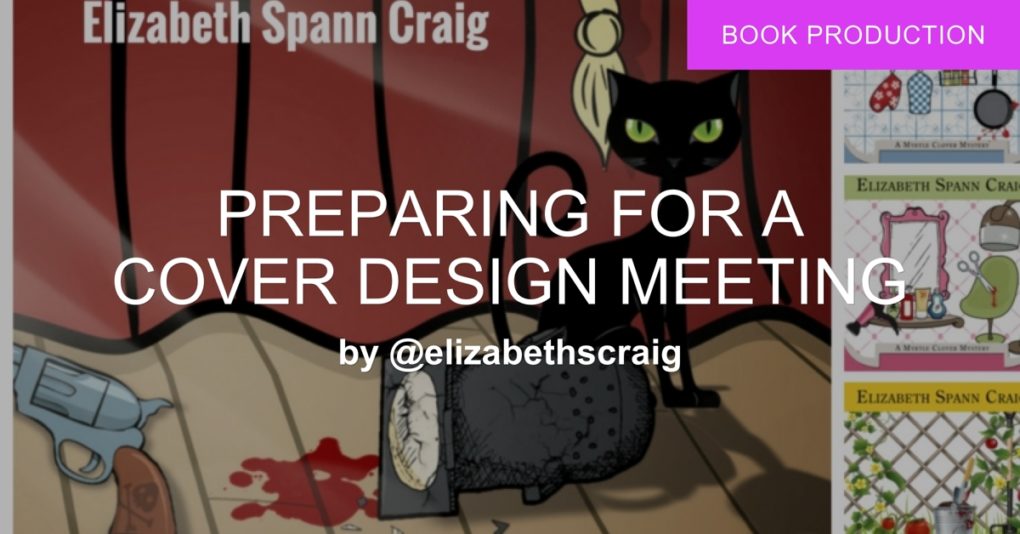by Elizabeth S. Craig, @elizabethscraig
There’s a lot to think about and remember for so many different aspects of book production and book release. I recently shared my checklist for releasing a book. Today I thought I’d list the different elements I pull together before meeting with my book designer.
The brainstorming portion:
For a first book in a series or the first time working with a designer, it’s helpful to reference/link to covers that appeal to you or that you feel represent your genre well.
I like to provide general element ideas to help the designer get started. For instance, where is the cover set? Are there any people or animals on the cover? What mood are you trying to set?
Printed books:
Designers will need to know your page dimensions.
If the book isn’t done yet (mine are usually not even started when I get the covers done), make sure to tell your designer you’ll need to check back in with the final page count (including all front matter and back matter) to ensure that the spine is the correct width.
You’ll want your bio and author photo for the back of the printed cover.
What’s your book’s price?
Be prepared with your back cover copy.
Other considerations:
Do you need an audiobook cover?
Do you need promotional extras like Facebook and Twitter cover images or bookmarks?
Payment:
I almost always pay for all book production services through PayPal after the cover is complete. It makes tax preparation easy to go through my PayPal statements at the end of each year.
Finally:
Because good designers book up quickly, I always go ahead set the next appointment with my designer, Karri Klawiter. Having a date on the calendar helps me to come up with a concrete concept for another project before our meeting.
Any other tips for keeping organized before a cover design meeting?
Preparing for a Cover Design Meeting: Share on X
Hi Elizabeth – that’s so helpful … obvious ideas – yet many newbies wouldn’t think about. Thanks so much … and setting the next meeting up – means you’re working and pushing yourself with the next book … cheers Hilary
Hilary–Always good to think ahead! Thanks for coming by.
With so many different formats today one simple book cover won’t do. This is a great checklist and would let a reader know a little about the book without reading a synopsis. I’m always disappointed when I pick up a book where the cover intrigues only to discover the story has nothing what-so-ever to do with what’s on the cover.
Thoughts in Progress
MC Book Tours
Mason–I know with trad-pub, sometimes I was startled by the covers. They were always lovely, but sometimes had little bearing on the story!
Do you book her before you’ve even written the story? Wow, now that’s setting a deadline.
Alex–I frequently book her for projects for the following year. Just helps me always look forward to the next project. :)
And be open to the fact that the cover designer won’t come up with exactly what you planned and it might even be better.
When I format books for others, I try to get the page count to them ASAP since they need it to create the template for the full wraparound. Plus you can’t determine the price or get the bar code until you know the size.
Diane–A very good point! I’m not a designer, nor do I even have a good eye.It’s good to see what a creative designer can produce!
Page count is really key for print.
This is really useful, Elizabeth! The better prepared one is for that sort of meeting, the more productive it’ll be, and the better the cover will look. I know my cover designer also wanted a very brief bit about my book, so there’d be a sense of what it’s about. Not a whole synopsis, but something to help with its general themes and tones.
Margot–Good point. We can’t expect designers to read our books…but synopses do help.
This isn’t a tip, just an observation. I work with a husband-wife team: the wife proofreads my copy, the husband formats, and designs my covers. Because the wife must read my stuff, she’s in a position to offer useful info to her husband regarding cover design inspired by content. I offer suggestions, and in this way, the job gets done. So far, so good.
Barry–A very efficient approach to book production! Sounds like a great team.